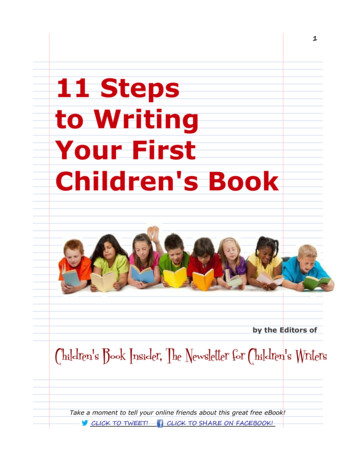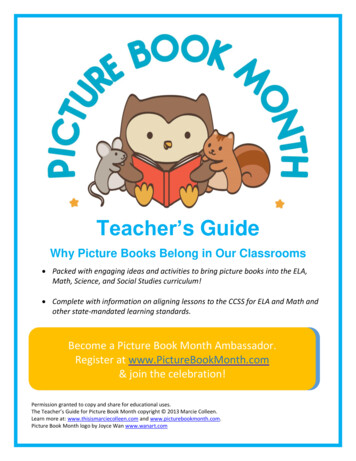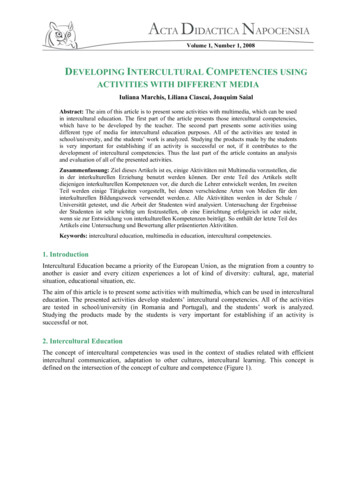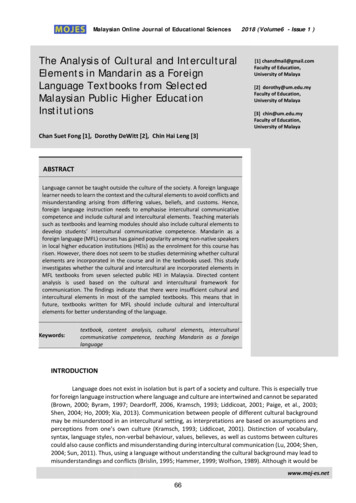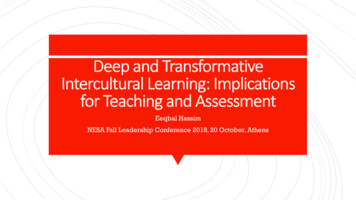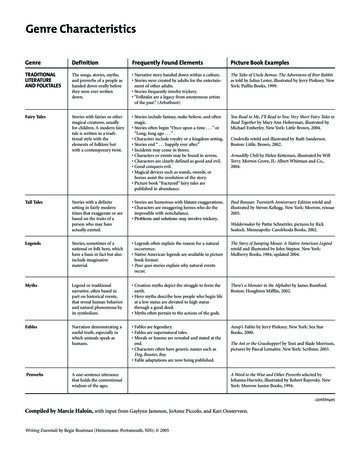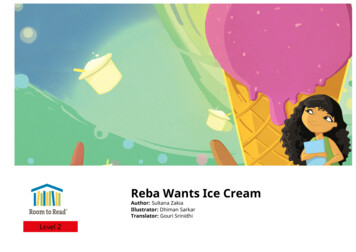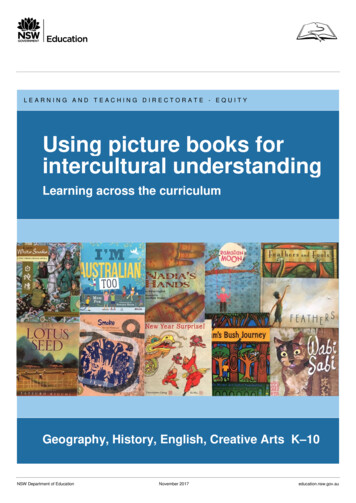
Transcription
LEARNING AND TEACHING DIRECTORATE - EQUITYUsing picture books forintercultural understandingLearning across the curriculumGeography, History, English, Creative Arts K–10NSW Department of EducationNovember 2017education.nsw.gov.au
ContentsAbout this resource3I’m Australian Too by Mem Fox and Ronojoy Ghosh4Sam’s Bush Journey by Sally Morgan, Ezekiel Kwaymullina and Bronwyn Bancroft6New Year’s Surprise by Christopher Cheng and Di Wu8Ramadan Moon by Na'ima B Robert and Shirin Adl10Nadia’s Hands by Karen English and Jonathon Weiner12Wabi Sabi by Mark Reibstein and Ed Young14The Lotus Seed by Sherry Garland and Tatsuro Kiuchi16Lady White Snake by Aaron Shepard and Song Nan Zhang18Smoke by Cao Wenxuan, Yu Rong (ill.), Duncan Poupard (trans.)20Feathers by Phil Cummings and Phil Lesnie22Feathers and Fools by Mem Fox and Nicholas Wilton24References and bibliography26 State of New South Wales (Department of Education), November 2017The copyright material published in this resource is subject to the Copyright Act 1968 (Cth), and is owned by the NSW Department of Education or, where indicated, by aparty other than the NSW Department of Education (third-party material).Copyright material available in this resource and owned by the NSW Department of Education, is licensed under a Creative Commons Attribution 4.0 International (CC BY4.0) licence. This licence allows you to share and adapt the material for any purpose, even commercially. Attribution should be given to State of New South Wales(Department of Education) 2017.Material in this resource not available under a Creative Commons licence: the NSW Department of Education logo, other logos and trademark-protected material material owned by a third party that has been reproduced with permission. You will need to obtain permission from the third party to reuse its material.This material is also licensed under the National Educational Access Licence for Schools (NEALS). Schools administered or represented by parties to NEALS may freelyreproduce and/or make available online or electronically transmit this material in whole or part for educational use.NSW Department of Education 2017education.nsw.gov.au2
About this resourceAs windows and mirrors, picture books can be a powerful vehicle in the classroom in terms of interculturaleducation for all learners. Anne Dolan, 2014 (author of You, Me and Diversity: the Potential of Picture Booksfor Teaching Development and Intercultural Education).When developing intercultural understandings, picture books can be both a: window into other cultures, providing a view of the world through a different lens, and amirror that reflects back the experiences of other people, which, through reflection, can help the readerbetter understand themselves and their own perspectives (Dolan, 2014 and Corapi and Short, 2015).This project was funded by Equity, Learning and Teaching Directorate of the NSW Department of Education.It aims to: explore dimensions of intercultural understandingprovide learning activities intended to develop students’ knowledge, skills, behaviours and dispositions inintercultural understandingsuggest learning activities based around picture books selected for their value in developing interculturalunderstandings and their literary worthoffer snapshots of learning that integrate intercultural understandings into history, geography, English andvisual artsinspire K–10 teachers to seek out and integrate picture books that develop intercultural understandings.Also applicable to the NSW syllabuses, the learning snapshots in this resource are guided by the AustralianCurriculum, Assessment and Reporting Authority (ACARA) intercultural understanding learning continuum. Inthe learning continuum, the key ideas for intercultural understanding are organised into three interrelatedelements: recognising culture and developing respectinteracting and empathising with othersreflecting on intercultural experiences and taking responsibility.These elements can be synthesised into Respect–Understanding–Action, a framework proposed by Dolan(2014) to provide multimodal approaches for ‘critical multicultural analysis’ of picture books (p 103). Written asa sequence of activities, the learning snapshots use Dolan’s framework, informed by the ACARA continuum.Two picture books per stage have been suggested as examples. Some of the books are suitable for multiplestages and syllabus content and many of the activities can be applied to other books. It is hoped that teacherswill look beyond their stage and subject area and adapt and modify the activities for their students. Otherpicture books suitable for developing intercultural understandings are listed in the Guide to Using PictureBooks in Geography K–10 and the Guide to Using Picture Books in History K–10.We have tried to select books that relate to various cultural groups, link to syllabuses, are not alreadyextensively expanded upon in teaching and learning resources, and are available in Australia. If copies ofbooks are not locally available, there may be video readings on YouTube or Vimeo. Single books, or classsets, may be available for loan through the Department of Education’s Henry Parkes Equity Resource Centre.We suggest that the first reading of a picture book be collectively shared and enjoyed in its entirety in acomfortable, relaxed space. For students learning English as an additional language or dialect it is important tobuild the field by ensuring they are familiar with all new culture specific vocabulary. Having available a classset, or several copies of the picture books, enables active student engagement in the text.Literature can provide a space for children to imagine, or recognise, what it is like to be a stranger, aforeigner, someone who is different. Mallan, et. al (2014)NSW Department of Education 2017education.nsw.gov.au3
I’m Australian Too by Mem Fox and Ronojoy GhoshEarly Stage 1 – History – Personal and Family HistoriesSynopsisFrom countries near and far, many have made their home in Australia, sharing itwith the original inhabitants, and living in peace beneath the southern stars.(Premier’s Reading Challenge 2018, K–2)Historical concepts and ideasCause and effect, Perspectives, Empathetic understandingBirthplaces and heritage of family members. Stories of families from the past.InterculturalunderstandingelementInteracting and empathising with othersEnglish conceptsPoint of view; RepresentationSelected syllabuscontentHow stories of the families and the past can be communicatedCommunicate across cultures: Students recognise that people use differentlanguages to communicate.Who the people in their family are, where they were born and raised and how theyare related to each other (ACHHK001).How the stories of families and the past can be communicated, for example throughphotographs, artefacts, books, oral histories, digital media and museums(ACHHK004). Students: Engaging with thetextdiscuss where members of their families were born and locate countries oforigin of students' families in the classuse a variety of sources including photographs or a treasured object from theirhomes, to recount stories about their families and discuss how sources areused to answer the question 'How do we know?'discuss the significance of the chosen treasured object or photographpose questions about another's object or photograph.Building the field: What are some of the countries in the world?Share the book with the students then re-examine the images, identifying therepresentations, viewpoints and familiar places.Making connections: Text to text – stories about places and families. Text to self –Who are the people in your family? Text-to-world – local advertisements for familyevents.What is your heritage? Where were members of your extended family born? Whatare their stories and how do they communicate them?Cross curriculumlinksEnglish – Grammar: rhyming words, past tense. Punctuation: question marksGeography – People Live in Places: Locating placesPDHPE – Relationships: getting along with each otherSupporting textsand resource linksSame, Same but Different by Jenny Sue Kostecki-ShawGuji Guji by Chih-Yuan ChenSame, But a Little Dif'rent by Kylie DunstanIntercultural Communication, NSW Department of Education and CommunitiesI’m Australian Too Teacher Notes, ScholasticNSW Department of Education 2017education.nsw.gov.au4
I’m Australian Too – Learning snapshotsRespect – birthplacesWhere were my family members born?‘Our mob’s been here forever – now we share the place with you.’Reread ‘I’m Australian Too’. Locate each country on a map of the world. At home,students ask their parents or carers where their extended family members wereborn, completed as a paper or online survey. At school, on a large world map, andmap of Australia, assist students in plotting the birthplace of their family members.In pairs, students make statements about their heritage. Using a world map andmap of Australia (in an atlas), they locate where their family members were born.They change partners and repeat the process.Image: Students locating places on a globe. Maxpixel. Public domain.Respect – my familystoriesWhat are the stories of my family members?‘My country was Afghanistan – we fled when I was small.’At home, students ask their parents about their story of coming to the place inwhich they now live. They ask them about the languages they spoke as a child andask them to share photographs and treasured objects when telling their story.In sharing circles, students recount their family’s story and discuss the significanceof the object or photograph. Students pose questions about other students’ storiesand photographs. They practise intercultural communication by listening carefully toeach other and showing respect for other students’ stories.As a class, discuss how family stories are communicated and shared, even whenpeople come from faraway places in which other languages are spoken.Understanding –communicating witheach otherHow do people communicate?‘My nonno came from Italy – his family followed after.’Students share the terms they call their grandparents. Why is using traditionalnames for our grandparents important to us and to others? Why is maintaining ourfirst language important to us and others?Revist the list of countries in ‘I’m Australian Too’ and identify the language spokenin each country. How would you communicate with a person from that country if youcouldn’t speak their language? How would people know how you are feeling?Play ‘backs in’: students stand in a circle, facing out. The teacher describes briefscenarios that engender emotion, for example ‘you open your lunch box to find atreat’. Count in and on ‘one’ students face into the circle in a statue showing howthey would react.How did you know how people were feeling? How did they communicate?Action – welcomingothersHow can we make people feel welcome?‘We open doors to strangers. Yes, everyone’s a friend.’Examine the illustrations of people in ‘I’m Australian Too’. In each, what are thepeople feeling? How do you know? Recall the importance of non-verbalcommunication such as facial expression and body language.The teacher describes a scenario to the students of a new child joining the classwho speaks another language, not yet able to speak English. Working in pairs,students take turns at being the new child and the ‘welcomer’. They role playactions they would undertake to include the child in the class and welcome them totheir new school. (Adapted from Education Directorate, ACT, n.d.)Image: Children helping each other. Pixabay. Public domainNSW Department of Education 2017education.nsw.gov.au5
Sam’s Bush Journey by Sally Morgan, Ezekiel Kwaymullina andBronwyn BancroftStage 1 – Geography – People and PlacesSynopsisSam is a city boy who doesn't much care about the wonders of the bush. Theshrubs are scratchy and the mosquitoes bite. To start, Sam thinks he wouldn't careif the bush disappeared but his attitude changes after his grandmother teaches himabout the place. (Premier’s Reading Challenge 2018, K–2)Geographical concepts and ideasPlace, Environment, InterconnectionConnections to places. Connections of people to local bushland racting and empathising with othersEnglish conceptsCharacter; Perspective; RepresentationSelected syllabuscontentLocal and global connectionsConsider and develop multiple perspectives: Students express their ownperspectives on familiar topics and texts, and identify the perspectives of others.Students investigate connections that people, including Aboriginal and Torres StraitIslander Peoples, have to local and global places, for example: (ACHGK010,ACHGK011, ACHGK012)- discussion of Aboriginal and Torres Strait Islander Peoples’ connections withland, sea and animals of their place- description of reasons people are connected to places in Australia and/orcountries across the world eg birthplace.Engaging with thetextBefore reading the words in the book, examine each of the illustrations and makeinferences about the story, the main character and his feelings and actions. Define‘nanna’ in the context of the story. Read the story, providing time to ponder over theillustrations.Making connections: Text to text – other texts illustrated by Bronwyn Bancroft, forexample, Big Rain Coming. Text to self – own experiences in bushland. Text toworld – local bushland and natural environments.Where does Sam’s nanna live? What are the features of the place? What did Samdo with his nanna when staying with her? What did Sam’s nanna teach him?Cross curriculumlinksEnglish – Visual literacy: layout, colour, framing. Grammar: verbs. Punctuation:direct speechHistory – Present and Past Family Life: present and past daily lives and traditionsScience and Technology – Living World: places that meet animals’ needsAboriginal and Torres Strait Islander histories and cultures – relationships withplaces and interconnections with environmentsSupporting textsand resource linksThe Lost Girl by Ambelin Kwaymullina and Leanne TobinMy Country by Ezekiel Kwaymullina and Sally MorganBig Rain Coming by Katrina Germein and Bronywn BancroftGeography Teaching Framework: Aboriginal Connections, NSW DoENSW Department of Education 2017education.nsw.gov.au6
Sam’s Bush Journey – Learning snapshotsRespect – people’splacesWhat are the features of places and how do we perceive them?‘Her house was surrounded by bush.’Re-read ‘Sam’s Bush Journey’, noticing the features of the forest, both in theillustrations and the words, eg ‘buzzed with mosquitoes’. Walk through a forestedarea of the school grounds or take a virtual walk using photographs and videos.With a partner, students imagine they are in the forest with Sam and his nanna andthey describe their inferences of the sights, sounds, smells and textures. In role asNanna, then as Sam, students lead a blindfolded partner on an imaginery physicaljourney of the forest in which they verbally describe the features.How were the journeys led by Sam and Nanna similar and different? Why? Whatare their connections to the place?What places have your grandparents or parents taken you that you liked? Are thereplaces you didn’t like at first? What did the place mean to your grandparents? Inpairs, students repeat the blindfolded journey exercise, taking each other on a‘virtual’ journey to a place visited with their grandparents or family.Image: Eucalypt forest. G BraidingUnderstanding –varying perspectivesHow are people’s perspectives on places similar and different?‘Nanna liked to walk deep into the gum forest.’Read the first three pages of ‘Sam’s Bush Journey’. Identify and discuss Nanna’sand Sam’s feelings about the forest.Using the sentence starter, ‘Nanna liked to but Sam ’ students write or speakthree sentences that express Sam’s and Nanna’s feelings about the forest. Why doyou think they have different feelings and perspectives about the place?In groups, students discuss how Sam’s experience connects to their experiences.Are there places your family likes to visit that you don’t like? How do you react?Understanding –heart mapsHow does understanding of places affect our perceptions?“I hope you’ll learn to love the bush one day, Sam,’ his Nanna said. And she toldhim about all the good things it had to offer.’Read the remainder of ‘Sam’s Bush Journey’. What did Sam’s nanna teach himabout the forest? How would Nanna have learnt her bush knowledge?List Nanna’s teachings in a table headed ‘Nanna’s said’ and ‘How Sam used it’.Does Sam like the forest now? Why or why not?Working in groups, students create a ‘heart map’ for Sam and his nanna. In a largeheart shape, students list or draw the feelings and attitudes that Sam has about thebush. They repeat the process for Sam’s nanna. How are the heart maps of Samand Nanna similar and different? Why?Action – caring forplacesHow can we care for places?‘The birds at the waterhole made a racket as Sam and Nanna arrived.’How could Nanna and Sam care for the waterhole so the water stays fresh forpeople and animals? How could they care for the forest and all the bush animals?Students discuss how they can respect and care for what is important to people.Students create an artwork about a place with which the students have aconnection, from their past or present. They write sentences, or explain verbally,how they can care for the place and be respectful of its users.NSW Department of Education 2017education.nsw.gov.au7
New Year’s Surprise by Christopher Cheng and Di WuStage 1 – History – Families Past and PresentSynopsisThe whole family is excited about the New Year Spring Festival. Everyone has aspecial job and Little Brother is anxious to know what his will be. His big brothersays that Little Brother is too small to help out. But, Father says that he has aspecial job. The story follows Little Brother through the new year preparations untilhe finally finds out his special job. (Premier’s Reading Challenge 2018, K–2)Historical concepts and ideasChange and continuity, Empathetic understanding, SignificanceChinese New Year Spring Festival celebration set in Northern China.InterculturalunderstandingelementReflecting on intercultural experiences and taking responsibilityEnglish conceptsCharacter; Context; RepresentationSelected syllabuscontentSignificance of timeReflect on intercultural experiences: Students identify and describe what they havelearnt about others from intercultural encounters and culturally diverse texts.How the present, past and future are signified by terms indicating time such as 'along time ago', 'then and now', 'now and then', 'old and new', 'tomorrow', as well asby dates and changes that may have personal significance, such as birthdays,celebrations and seasons (ACHHK029). Students: Engaging with thetextidentify days, holidays, events celebrated by students and their families anddiscuss cultural differences in days celebrateddefine and use terms relating to time, sequencing objects or photographs fromthe past, eg then and now, past and present, a long time ago.Before reading the words in the book, examine each of the illustrations and makeinferences about the story, the family, their roles and traditions in their celebration.Making connections: Text to text – Texts about Chinese New Year celebrations.Text to self – family celebrations of Chinese New Year and other special events.Text to world – Chinese cultural influences in Australia.Share some of the factual information provided in the last two pages of the book.Use this to discuss how the author and illustrator obtained information for theirwriting and illustrations and, in particular, the role of primary sources.Cross curriculumlinksEnglish – Grammar: descriptive verbs, proper nouns. Punctuation: direct speech.Visual literacy: vectors, colourGeography – People and Places: Local and global connectionsCreative arts – explore how artists reflect upon different aspects of the worldthrough artworks and artmaking. Traditional Chinese music and dance.Asia and Australia’s Engagement with Asia – Chinese cultural traditionsSupporting textsand resource linksNSW Department of Education 2017Fang Fang’s Chinese New Year by Sally RipponNew Year’s Reunion by Yu Li-Qiong and Zhu Chen-LiangIntercultural Communication, NSW Department of Education and CommunitiesNew Year’s Surprise! Teacher Notes, National Library Australiaeducation.nsw.gov.au8
New Year Surprise! – Learning snapshotsRespect – ChineseNew Year eventWhen is Chinese New Year and how is it celebrated?‘Everyone in our village is preparing for the new year Spring Festival.’Locate China, and its northern area, on a map or globe. Locate Australia. View theillustrations in ‘New Year Surprise!’ to describe the weather during Chinese NewYear in northern China. Note that it is also called the new year Spring Festival.Mark the date of Chinese New Year on a calendar, stating the month andidentifying the season in Australia. Explain that in the northern hemisphere this isthe beginning of spring, marking a new year of growth, but in northern China it isstill very cold and snowy.Re-read ‘New Year Surprise!’ and jointly construct a written or visual timelinerepresenting the sequence of preparations and celebrations shown in the book.Invite parents with Chinese heritage to explain their families’ Chinese New Yearpreparations and celebrations. Students also share their own experiences. How arestudents’ experiences similar and different to those represented in the book?Students create a visual Venn diagram that shows differences and similarities in thecelebration between northern China and local places.Image: Chinese New Year dragon. Pixabay. Public domainUnderstanding –Chinese New Year innorthern ChinaHow does the northen Chinese family celebrate Chinese New Year?‘When the relatives arrive we give them tea.’Revist the illustrations in ‘New Year Surprise!’. Students ‘step into the story’ tocreate a freeze frame of each part of the new year celebrations. For instance, thefirst freeze frame will be a group of eleven students recreating the illustration of theextended family sharing tea. What are the roles of the various family members?On a signal, students bring the freeze frame to life, adding speaking and actions.These could be videoed and spliced together to create a movie of the sequence ofcelebrations. Students describe the feelings of the characters they played.Respect – familycelebrationsWhat special events does my family celebrate and when are they?‘Father has already pasted the red banners with Spring Festival messages on thefront door.’Revisit the illustrations in ‘New Year Surprise!’ to identify the Chinese New Yeardecorations. When does your family display decorationsand what do they mean?What special events does your family celebrate? How do you know when theyoccur and to prepare for them?Students ask their parents or carers for a list of dates of their main familycelebrations. At school, students plot the dates onto a personal yearly calendar,adding an illustration, symbol or decoration that represents each special day.Working with a partner, students compare their calendars and explain the events.Generate a class list of special events celebrated and discuss cultural differences.Action – consensusboardWhat have I learnt about others?‘Together we will lead the Dragon and he will bring good fortune to our village.’Working in groups of four, students create a consensus board. Using one sectioneach, students write what they personally learnt about others through the ‘NewYear Surprise!’ story and activities. Students share these with their group, listeningcarefully to each other and showing respect for other students’ thinking. They cometo consensus on what their group learnt and write this in the centre to share withthe class.NSW Department of Education 2017education.nsw.gov.au9
Ramadan Moon by Na'ima B Robert and Shirin AdlStage 2 – History – Community and RemembranceSynopsisMuslims all over the world celebrate the month of Ramadan. The story explains afamily’s special activities during the celebration, and the significance of Ramadan,which starts with a new moon and continues to the first sighting of the second newmoon. This marks the end of the month of fasting and commencement of the bigcelebration, Eid-ul-Fitr. (Premier’s Reading Challenge 2018, 3–4)Historical concepts and ideasContinuity and change, Empathetic understanding, SignificanceThe significance of Ramadan and how it is celebrated by Muslim families acrossthe world.InterculturalunderstandingelementRecognising culture and developing respectEnglish conceptsCode and convention; Context; Point of viewSelected syllabuscontentCelebrations and commemorations in other placesExplore and compare cultural knowledge, beliefs and practices: Students describeand compare a range of cultural stories, events and artefacts.Celebrations and commemorations in other places around the world; for example,Bastille Day in France, Independence Day in the USA, including those that areobserved in Australia, such as Chinese New Year, Christmas Day, Diwali, Easter,Hanukkah, the Moon Festival and Ramadan (ACHHK064). Students: Engaging with thetextidentify global celebrations and commemorations, including those of the majorworld religionsdescribe the origin of these celebrations.Share the book with the students, or view the Storytime for Kids reading of thebook. When is Ramadan? What are its origins and how is it celebrated?Making connections: Text to text – texts about significant celebrations from aroundthe world. Text to self – global events celebrated by students’ families. Text to world– Muslim influences in our local areas and cities.What national and global events does your family celebrate? What family traditionsare a part of your celebrations?Cross curriculumlinksEnglish – Grammar: lyrical poetic form, similes, repetition, conjunctions, noungroups. First person narrative. Visual literacy: layout, demandGeography – Places are Similar and Different: Similarities and differences betweenplacesCreative Arts – explore how artists can interpret the world and traditionsSupporting textsand resource linksNSW Department of Education 2017Storytime for Kids: Ramadan Moon (Islam Channel), Na’ima B. Robert, 2015Ramadan, Behind the News, ABC, 2011 (3:35min)Under the Ramadan Moon by Sylvia Whitman and Sue WilliamsLin Yi’s Lantern by Brenda Williams and Benjamin Lakombe (PRC K–2)Mooncakes by Lorretta Seto and Renne BenoitIntercultural Communication, NSW Department of Education and Communitieseducation.nsw.gov.au10
Ramadan Moon – Learning snapshotsRespect – RamadancelebrationWhat are the origins of Ramadan and how is it celebrated?‘Ramadan, the month of fasting, doesn’t begin all at once. It begins with a whisperand a prayer and a wish.’Re-read ‘Ramadan Moon’ to develop an understanding of the origins and elementsof the Ramadan celebration. Invite students of Muslim faith to provide informationon their experiences of Ramadan and Eid activities and celebrations. Studentsdemonstrate respectful and empathetic listening and questioning.Students view the 3:35min video Ramadan, Behind the News, ABC, 2011, as anadditional source of information. They create a table to summarise the mainelements of the Ramadan celebration.Moon phase /sunrise, sunsetRespect – localglobal celebrationsSignifiesActivitiesHow I knowWhat celebrations and commemorations are held in other places around theworld, including those observed in Australia?‘Muslims of every nation, of every age and every hue will join the celebration.’Examine the illustration of the globe in ‘Ramadan Moon’. What visual elementsreinforce the observance of Ramadan globally? For what other global celebrationswould this illustration be suitable? What global celebrations are celebrated locally?Students undertake independent research into a global celebration that their familydoes not observe. Suggested celebrations: Chinese New Year, Moon Festival,Easter, Christmas, Rosh Hashanah, Hanukkah, Diwali.Students organise their information and reactions in a table. They share theirinformation with other students in respectful sharing circles.QuestionUnderstand –cultural X-rayAnswerSourceReactionsWho are we? How are our cultural values and attitudes similar and different?‘As I look out on the night sky, my smile is bittersweet.’Revisit the illustrations in ‘Ramadan Moon’ and locate the narrator in eachillustration. Use the words and pictures to identify her feelings on each page.Students create a ‘cultural X-ray’ of themself and of the narrator or her brother.They draw an outline of a body shape with a large heart shape inside. In the heartthey write their inner values and beliefs, and people and events important to them.Guide students by asking questions such as: What do you like? What are yourbeliefs? Who is important to you? What events are important to you? Around thebody shape, students describe outwardly known aspects of their identities, eg age,language, heritage. Students repeat the exercise for the narrator or her brother.Students compare the two cultural X-rays, identifying similarities and differencesbetween them. (Adapted from Short, n.d.)Image: Person on swing reflecting on life. Pixabay. Public domainAction – reflectionHow can we understand and respect what is important to people?Reflect on the cultural X-rays activity. What did you learn about yourself and yourpeers? Discuss the concepts of uniqueness, diversity, respect, empathy andunderstanding as they relate to the class, school and local community.Students use Think-Pair-Share to answer the question: How can we understandand respect cultural and religious values that are important to people?NSW Department of Education 2017education.nsw.gov.au11
Nadia’s Hands by Karen English and Jonathon WeinerStage 2 – Geography – Places are Similar and DifferentSynopsisNadia has Pakistani heritage and
NSW Department of Education 2017 education.nsw.gov.au 3 As windows and mirrors, picture books can be a powerful vehicle in the classroom in terms of intercultural education for all learners. Anne Dolan, 2014 (author of You, Me and Diversity: the Potential of Picture Books for Teaching D
